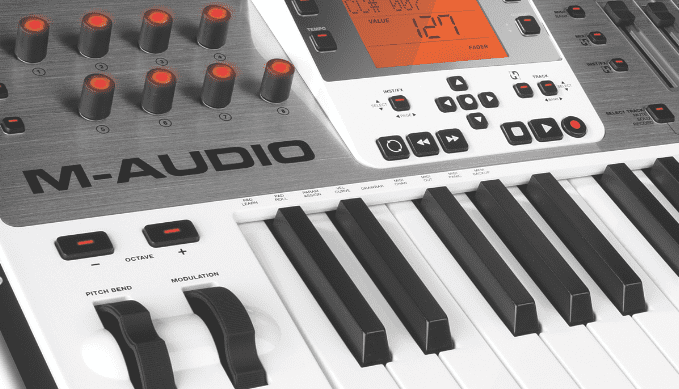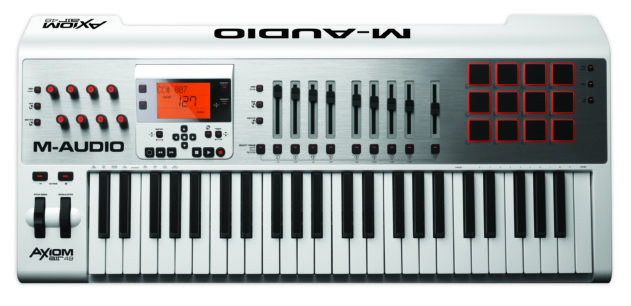M-Audio updates its controller keyboard range, introducing a new flagship. Is the updated automap feature an improvement? Yes… unless you’re a Logic X user.
There’s no need to reinvent the wheel. Instead, with the Axiom AIR, M-Audio try to make the wheel slicker, a bit more versatile and a lot more efficient. Have we stretched this metaphor far enough? Probably. In slightly more straighforward terms, the Axiom AIR represents M-Audio’s new flagship MIDI controller: improved HyperControl automapping functionality, small layout alterations and a scattering of new features.
All of which means that the current Axiom range comprises the regular version, the updated Pro model with HyperControl and now the AIR, which is available in 25-, 49- and 61-key versions, the smallest of which sacrifices all but one of the sliders but gains extra pads. There’s also the Axiom AIR Mini 32, which is an altogether more portable version of the concept, albeit with a major emphasis on portability over features – if portability isn’t the top priority you’ll probably want the 25 instead. The 49-key version on test here offers the most obvious compromise between size and features.
AIR time
At over 80cm long, nearly 40cm deep and just under 5kg it’s certainly not small, but what you lose in desk space you gain in functionality: in addition to the 49 keys, you’ll find eight rotary encoders, nine 70mm sliders, each with a corresponding push-button for channel mute/solo/select, plus a bank of 12 pads. It’s worth noting that the rotary controls have been moved to the left-hand end of the front panel, which makes more sense when playing keyboard parts with the right hand – parameters can be adjusted in real-time without having to cross your arms to reach the rotaries, as you’d be forced to do with the Axiom Pro.
The basic spec includes everything you’d expect to find on a keyboard in this price bracket: velocity- and aftertouch-sensitivity, flexible MIDI mapping and a large orange-backlit LCD screen. As you’d also expect, it features a full complement of connectivity options on the back panel, including USB and DIN sockets for MIDI plus optional expression and sustain pedal connectors.
The action of the keybed itself is slightly heavier than the feather-light synth actions which seem to be in vogue for most MIDI controllers (the 61-key version features a slightly different, semi-weighted action). All controls are solidly built, although the sliders are a little gritty and don’t feel quite as sturdy as the rotaries. The pads are responsive and feel tough.
Of particular interest here is the ‘roll’ function, broadly similar to the highly regarded ‘note repeat’ option on MPCs. Engage roll, hold down a pad and it’ll retrigger in time with the current tempo setting (either synced to a DAW or free-running and adjusted manually, triggered by an internal clock). Varying pressure on the pad allows for real-time expression. The function offers control over rhythmic subdivisions from 1/4 to 1/64, swing and note length. Incredibly useful for drums and also potentially interesting on other sounds.
Swell maps
The AIR will be of particular interest to users whose workflow demands flexible control over numerous parameters of their equipment and software simultaneously. As such, the customisable mapping and HyperControl automapping features of the keyboard are key selling points – after all, if you don’t need them you may as well buy a cheaper, more simple alternative. The mapping features of the Axiom Pro remain, but crucially each set of controls can quickly be toggled between manually mapped MIDI, HyperControl mix and HyperControl instrument/effect modes using dedicated buttons.
HyperControl itself remains something of a mixed blessing. It’s not a perfect system, but no automap system is. In use, it does a fair job of automatically assigning software parameters to the keyboard’s knobs and sliders. The feature currently supports M-Audio partners AIR’s Ignite software, Ableton Live, Cubase, GarageBand and Logic 9 via downloadable drivers. Pro Tools support is under development. Sadly, using the AIR with Logic X means resorting to a clumsy workaround – I managed to get it running just about correctly by installing the HyperControl bundle for GarageBand and copying it into Logic X’s MIDI Device Plug-ins folder (right-click the application icon and choose Show Package Contents for access to the data files). Users of Reason, FL Studio, et al., are out of luck altogether.
However, on top of the automatic HyperControl options it’s worth noting that the AIR’s programming options are as extensive as they come – up to 128 separate mapping configurations can be saved to memory, each containing hundreds of custom parameter mappings.
Conclusion
A good MIDI controller keyboard should be one of the most used pieces of hardware in your studio. The Axiom AIR is in the top tier of controllers which tries to bundle everything into one convenient package. Although there are issues with HyperControl, there’s certainly enough here to suit most users – so long as your DAW is supported. As is the custom with MIDI controllers these days, the AIR also comes bundled with software: in this case a copy of Pro Tools Express, with the added bonus of an iLok 2 key in the box for good measure.
The Axiom AIR is a solid, well-built controller with a wealth of mapping options and sufficient pads, sliders and rotaries to suit most users. We’d warn Logic X users that HyperControl functionality isn’t yet up to scratch, but otherwise the AIR is an excellent option if ultra-flexible MIDI control is an essential part of your production process.
The Verdict
Price: £329
Purchase: M-Audio Axiom AIR 49
The Final Word
A versatile MIDI controller but HyperControl compatibility leaves a little to be desired.

